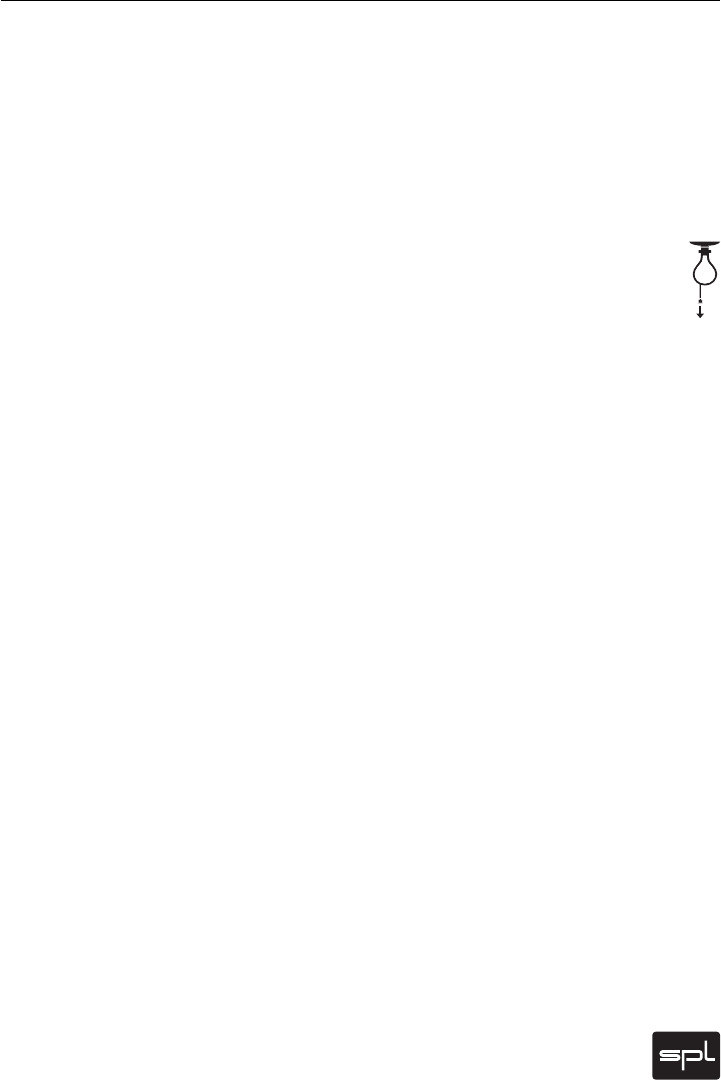
7
Volume 2
Volume Control
The single volume potentiometer controls volume for both channels. The
audio signal is controlled directly by the potentiometer—thus no VCA or DAC
regulators in the paths which tend to produce bigger tolerances and distor-
tions.
The scale of this control has been purposely marked in percentage rather than
in dB values. A dB scale would not make too much sense because we cannot
plan for absolute values in signal level reproduced by individual systems and
in playback rooms.
Calibrating the Monitoring System
Both the signal level which is send to the Volume 2 controller as well as the
input sensitivity of the power amps or active speakers should be matched to
ensure a proper overall gaining. An inappropriate adjustment might happen
when, for example, a (fairly small) 10% volume level setting might already
result in an extremely high playback level.
Important: You can encounter very loud signals during calibration, so be sure
to keep your ear protection on. For calibration we recommend measurement
with a Real Time Analyzer (RTA) or a SPL Meter (in this case, SPL translates to
“Sound Pressure Level“). First the measuring machine and microphone are
set up at the listening position. Then one produces in the DAW a sound fi le
with “pink noise”, which is played back and measured.
Each measurement should be done through one channel and loudspeaker
at a time. A recommendable calibration is the playback of a 83db SPL refer-
ence signal at the playback location—a common reference volume level. The
DAW output level should be adjusted to 0 dB, and next, the power amp‘s or
active speaker‘s input level should also be set to 0 dB. Now the Volume 2 level
control is adjusted until the RTA or SPL Meter measures 83 dB with the pink
noise playback. For a perfectly matched gaining the Volume Control would
now be set above a 50% scale position. At this point one can record or note
the exact value for 83 dB. Should this 83 dB SPL occur markedly above a 60-
80% scale position, one should lower the power amp’s/active speaker’s input
sensitivity (=higher dB value). On the other hand, the power amp’s/active
speaker’s input sensitivity should be raised if the 83 dB SPL point is reached
far before the 60% control level. In cases where regulating power amp/active
speaker inputs is not enough, one may reach good values by changing the
D/A converter output level (for example from +4 dB to 0 or -10 dB in cases
where this switch option may exist). In any case, the converters should always
be driven at full scale from the DAW.
Mute
You guessed it ... this switch mutes all speaker outputs. It is particularly
valuable in panic situations, for example, if the computer crashes and its
converters suddenly output uncontrolled high level noise. It is also ver y useful
in any case where one simply wants silence without changing the Volume
settings—e. g. to answer the telephone.
IMPORTANT: When making any cable connection changes, you should not
only activate the mute switch, but follow the on/off powering procedures
noted on p. 6.
Operation














